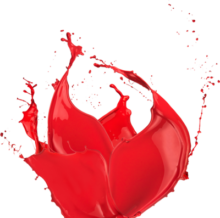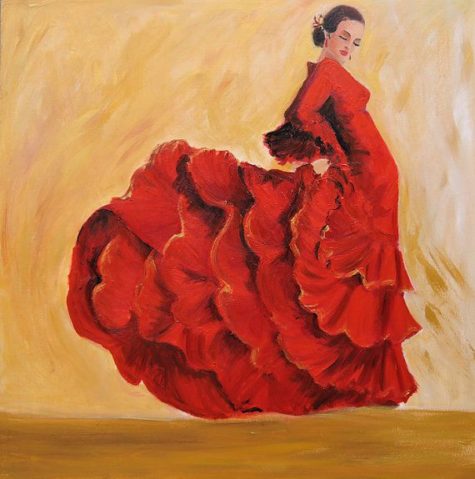Red
 Symbolic Meanings of the Color Red:
Symbolic Meanings of the Color Red:
- Vitality and Life Force
- Fire
- The Sun
- The South
- Blood
- Good Luck and Prosperity
- Power and Authority
- Masculine Energy
- War and Anger
- Passion
- Energy
- Sexuality
One of the three primary colors, bright red pops out of whatever environment it happens to be in and grabs our attention more than any other color. Moreover, it is the first actual color that is seen by babies.
Because it has a lower vibrational frequency than any other color in our visible spectrum, it is associated with the Root Chakra and symbolizes passion, sexuality, fertility and animal urges. Red-light districts are so called because of the dim red shades of the prostitutes’ quarters.
Red is the color of blood, which means that it is associated with the life-forces and vitality. Hunters would daub themselves in the red blood of the kill, which they believed would give them empathy with the spirit of the animal. Red is also the color of fire, the Sun and the Southern direction.
The word for “magic,” in German is directly linked to the word for “red ochre.” A recent archaeological discovery provided unusual evidence of the reverence in which the color was held by early man. Lumps of red ochre, as well as tools stained with the substance, were found in early graves in an Israeli cave, indicating its importance as a symbol of vitality, life, and resurrection.
Pure colors used to be very difficult and expensive to produce, and so red cloth was used by people in positions of power, such as the monarchy and the clergy. Byzantine emperors were dressed from head to food in red. In Rome, red was the color of nobles and generals, and the Holy Roman Church still dresses its cardinals in pure, bright, cardinal red. To roll out the red carpet for someone is to honor their presence.
Red is the color of protection and has been viewed as such for at least the last 2000 years. Amulets made from rubies or garnets were far more valuable than any other kind, able to make the wearer invincible.
 And then there is the red planet. Mars has a preponderance of iron oxide in its soil that gives it a red appearance that is clearly visible to the naked eye. This color is partially responsible for its association with war and warriors.
And then there is the red planet. Mars has a preponderance of iron oxide in its soil that gives it a red appearance that is clearly visible to the naked eye. This color is partially responsible for its association with war and warriors.
In India and China, red is the traditional color for weddings. Indian brides wear saris of red or pink, and the Chinese happy couple will be surrounded by a veritable sea of red, clothing, souvenirs, and gifts. Even the home of the bride and groom are decorated with red banners and ribbons. Roman brides, too, favored red for their wedding veil, which was called a flammeum. This tradition is shared by modern Greek brides.
The red envelope is a popular Chinese symbol for happiness. It has been a long-standing belief that red envelopes bring happiness, good luck and prosperity. In fact the color red stands for all these, in itself. So the person gifting these wishes the person receiving it to be bestowed with all these things.
By contrast, red is the color worn by mourners in South Africa. Red was also the color of the communist revolution in Russia, and so politically it is associated with communist causes.
In Ancient Egypt red was synonymous with evil, because it was the color of the God Seth, who haunted the arid desert places, the personification of destruction. Seth was called the “Red God,” and an Egyptian charm of the time goes like this:
Oh, Isis, deliver me from the hands of bad, evil, red things!
Similarly, in Christian symbolism, the Devil is sometimes depicted as a red creature. Like Seth, he also has a predilection for scorched places.
In alchemy, the Red Stone is mercuric sulfide, a compound of sulfur and mercury that is also called vermilion. The creation of vermilion was a very important primary stage in the process of making the Philosopher’s Stone, which is itself disguised as the Red Lion, since this elusive substance was characterized by turning red in its final stage.
Other meanings associated with the color red:
- When the color green and the color red are combined, they traditionally represent Christmas and the joyous holiday season.
- Red is often associated with the fortieth wedding anniversary, as the red ruby is the traditional fortieth wedding anniversary gift.
- Barns and large structures have been traditionally painted red because the red paint was the most inexpensive paint to purchase and the easiest paint to manufacture.
- A red rose without thorns is a symbol of passion, love, and romance.
- A red rose with thorns typically exemplifies the struggle and challenges associated with journey of love, meaning that it can be both joyous, fulfilling and delicate, as well as painful and cruel.
- The saying “in the red” means losing money, no money, or overdrawing your account at the bank and is thought to come from the feelings of stress and anxiousness and the physical symptoms they cause such as elevated blood pressure and often anger or danger.
- The term “red herring” is used when referencing something that is deceiving, dishonest, or distracting from the truth.
- The phrase “paint the town red” is associated with celebration, partying, abandon, fun, and excitement.
- The expression “seeing red” is thought to be based on the physical characteristic of anger, including redness of the cheeks, physical exertion, and elevated blood pressure.
- The term “red eye” is associated with overnight airline flights due to the perceived lack of sleep passengers receive and the appearance of red in the whites of their eyes as a result.
- The saying “red carpet treatment” refers to making someone feel special and pampered as if they are a VIP or high profile person.
- The phrase “red flag” is often used in reference to a warning of danger, problems, fighting, and war.
Collected from various sources.






thanks for info